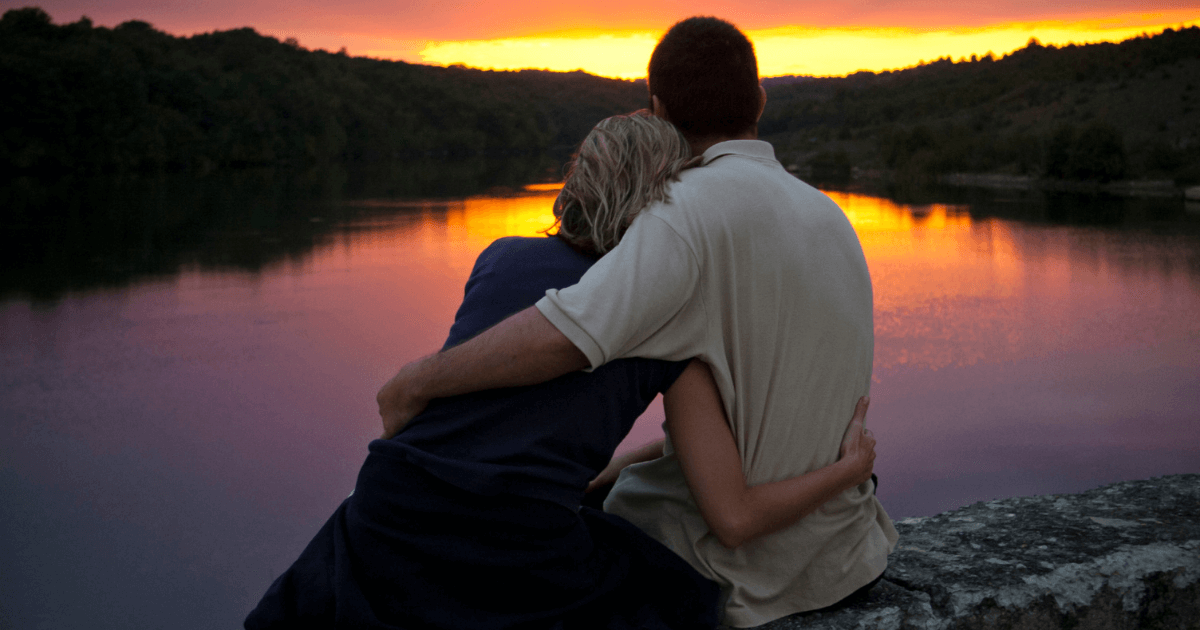
If you’re writing love stories, then you’ll want to get familiar with romance tropes. They act as familiar signposts for readers, so they know what to expect from your novels.
By the time you finish reading this article, you’ll be familiar with 50 of the most popular romance tropes in the literary world, and you’ll be able to use them to connect with readers and enhance your storytelling skills.
What Is a Trope in Books?
I’ll bet you’ve heard the word trope before because it seems like that’s all writers talk about. But you might not know what a trope is or how to use it in your fiction writing. Well, fear not my writerly friend. By the time we’re through here, you’ll be a trope expert.
A romance trope expert.
A trope is a convention, theme, character archetype, situation, or set of circumstances specific to a particular genre. Some may call tropes cliche or overused, but I prefer to think of tropes as shorthand to let readers know what they can expect from your books.
And readers, particularly romance readers, are trope connoisseurs.
When you tell a romance reader that a book is enemies to lovers, they’ll instantly know what your book is about and—crucially—whether it’s for them. If you tell them the dynamic between your love interests is grumpy/sunshine, they’ll know one love interest is grumpy, and the other is positive, and, if it’s a trope they love, they’ll snap your arm off to read your novel.
So, whether you write straight up romance, or you’re writing in a genre where romantic subplots are key, this article is for you.
Now you know what a trope is, let’s get specific and examine 50 romance tropes for writers so you can communicate your book’s central theme to readers with effortless ease. I’ve included a definition of each trope, explained how it’s characterized, and added an example of a romance book that has the trope in it.
And no, I will not apologize for adding to your TBR!
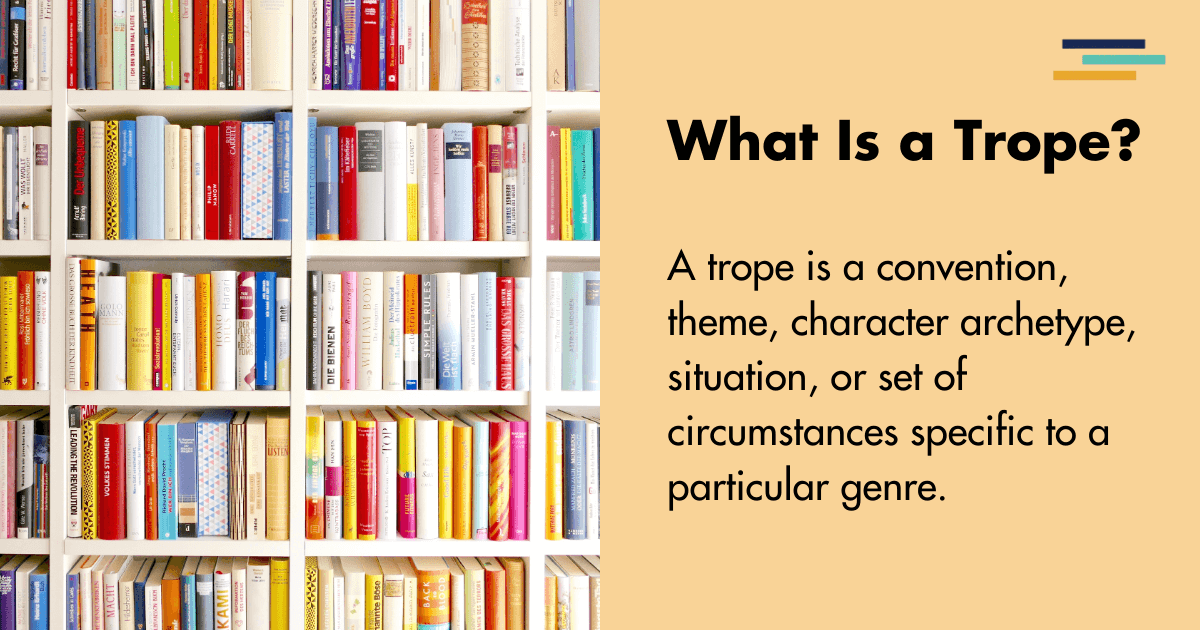
Love Tropes
- Enemies to Lovers: Love interests who start off hating each other, but gradually grow to love each other. Characterized by banter, tension, and chemistry, often involving heated arguments. Example: The Hating Game by Sally Thorne.
- Friends to Lovers: Love interests who start out as friends and develop romantic feelings for one another. It’s characterized by exploring existing bonds and the realization that sometimes love was waiting for you all along. Example: Love, Rosie by Celia Ahern.
- Forbidden Love: Love interests who love each other, but can’t be together because circumstance, family, or society forbids their relationship. It’s characterized by defiance and breaking societal norms. Example: Beautiful Disaster by Jamie McGuire.
- Love at First Sight (Insta-Love): Love interests who fall for each other as soon as they meet. It’s characterized by the exploration of an instant, powerful connection you can’t resist where the relationship seems destined. Example: November 9 by Colleen Hoover.
- Secret Admirer: One love interest has feelings for another but only expresses those feelings anonymously. It’s characterized by mystery, tension, and anticipation because one love interest is trying to find out who the secret admirer is. Example: Simon vs. the Homo Sapiens by Becky Albertalli.
- Soul Mates: Love interests who are destined to be together and who can only be with each other because they are two halves of a unique whole. It’s characterized by the idea of the perfect match and a deep, sometimes supernatural connection. Example: A Court of Thorns and Roses by Sarah J. Mass
- Unrequited Love: One love interest has romantic feelings for another, but the other love interest doesn’t reciprocate. It’s characterized by longing, the pain of rejection, and hope. Example: One Day by David Nicholls.
- Love Triangle: Where one character can’t choose between two potential love interests. It’s characterized by themes of complex relationships, freedom of choice, loyalty and betrayal. Example: Twilight by Stephenie Meyer.
- Second Chance Romance: Characters who were in love (or in a committed relationship with each other), became separated but eventually found their way to each other again. It’s characterized by themes of forgiveness and a love that endures. Example: The Best of Me by Nicholas Sparks.
- Reformed Rake: One love interest has a promiscuous past but falls in love and changes their ways. It’s characterized by character growth and a redemption arc for the roguish half of the couple. Example: Wallbanger by Alice Clayton.
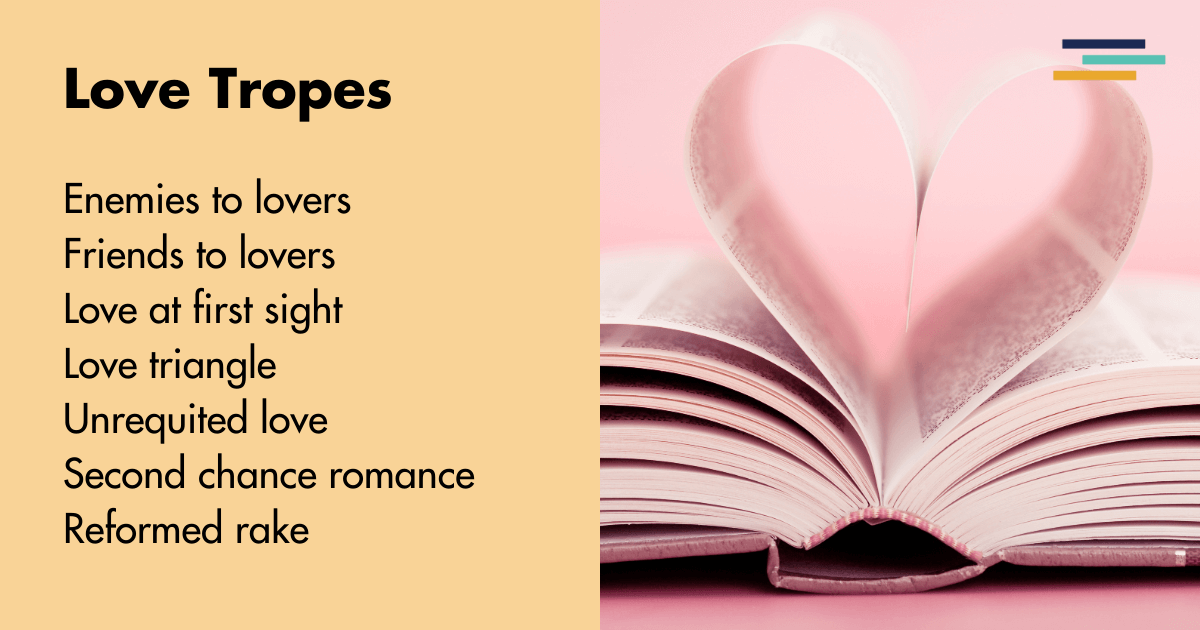
Relationship Tropes
- Fake Dating: The love interests pretend to be in a relationship because it’s helpful to one or both of them. Eventually, they develop genuine feelings for each other. It’s characterized by the balance between emotion and humor. Example: To All the Boys I’ve Loved Before by Jenny Han.
- Marriage of Convenience: Two love interests who don’t love each other marry for practical reasons and fall in love after the marriage. It’s characterized by a theme of unexpected love. Example: The Marriage Bargain by Jennifer Probst.
- Opposites Attract: Love interests who have opposite personalities fall for each other. It’s characterized by misunderstandings, comic situations, and an exploration of how personal differences can balance each other out. Example: The Rosie Project by Graham Simsion.
- Long-Distance Relationship: The love interests are physically apart, either by choice or because someone or something enforces their distance. It’s characterized by themes of trust and the importance of open communication. Example: Where Rainbows End by Cecelia Ahern.
- Childhood Sweethearts: Where the love interests have known each other since they were kids, are friends initially, then fall in love. It’s characterized by the characters growing up together and themes of deep bonds formed over a long time: Example: Every Last Word by Tamara Ireland Stone.
- Forbidden Teacher/Student: This trope deals with the ethical issues that arise from a teacher/student relationship. It’s characterized by themes of societal taboos and power dynamics. Example: Gabriel’s Inferno by Sylvian Reynard.
- Age Gap: As the title suggests, this trope focuses on a relationship between an older love interest and a younger one. It’s characterized by the exploration of themes like life experience, maturity, and unconventional love stories. Example: The Idea of You by Robinne Lee.
- Fake Marriage: Similar to fake dating, this trope is all about characters who marry because it’s helpful to one or both of them. It differs from marriage of convenience because there’s usually a comedic element to the trope. Example: The Unhoneymooners by Christina Lauren.
- Tragic Past: Where one or more of the love interests have tragic pasts, and the trauma they’ve suffered affects their relationship. It’s characterized by emotional depth and complexity. Example: It Ends with Us by Colleen Hoover.
- Runaway Bride/Groom: These love stories involve a bride or groom fleeing their wedding and end with them embarking on a relationship with their true love. It’s characterized by a journey of self-discovery for the love interest who ran away from their wedding. Example: Save the Date by Morgan Matson.
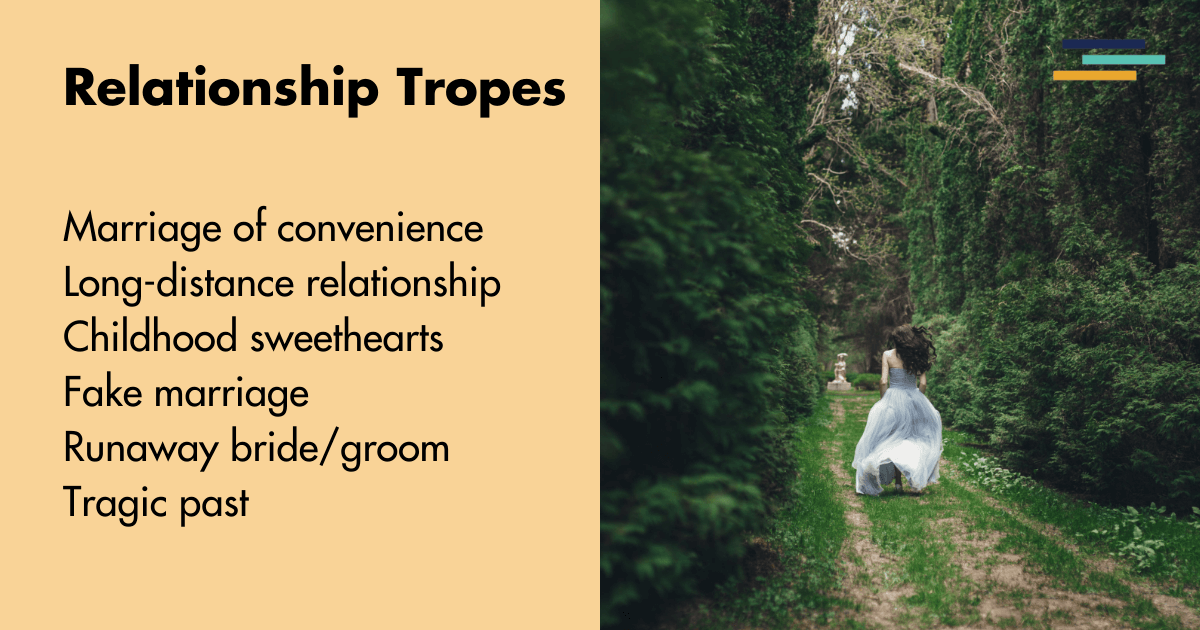
Couple Tropes
- Bad One/Good One: This is a romance between a rebel and a square. It’s characterized by a plot that leads to both characters transforming each other for the better. Example: Real by Katy Evans.
- Grumpy/Sunshine: Where one love interest has a jaded and cynical personality while the other is joyful and optimistic. It’s characterized by a contrast in personalities and a softening of the grumpy character. Example: The Flatshare by Beth O’Leary.
- Best Friend’s Sibling: The main character falls in love with their best friend’s sibling. It’s characterized by the exploration of themes like betrayal, loyalty, and tension between the main character and their best friend. Example: Josh and Hazel’s Guide to Not Dating by Christina Lauren.
- Step-Sibling Romance: This is a romance between step-siblings. It’s characterized by exploring the complexities that can arise in blended families and challenging societal taboos. Example: Stepbrother Dearest by Penelope Ward.
- Hate to Love: Where the love interests despise each other when the novel opens and love each other when it ends. This trope is like enemies to lovers, but the hate is more deeply ingrained at the start of the book. It’s characterized by a gradual shift in emotion from negative to positive. Example: The Kiss Quotient by Helen Hoang.
- Cinderella Story: This trope often involves a wealthy love interest transforming the life of a less affluent love interest while they fall for each other. It’s characterized by themes of transformation and redemption. Example: The Selection by Kiera Cass.
- Secret Royalty: One love interest hides their royal heritage from the other to protect themselves. It’s characterized by themes of mistrust, loyalty, and royal duty. Example: Royalty Lost by Angie Stanton.
- Cowboy Romance: A romance where one love interest is a cowboy, and the setting is usually a ranch, or the countryside. It’s characterized by a feeling of rural charm and an idyllic portrayal of the simple life. Example: Long, Tall Cowboy Christmas by Carolyn Brown.
- Amnesia Romance: The two love interests are usually already in a relationship when a tragic accident leaves one of them with amnesia, and the affected party gradually falls in love with their partner all over again (because their memory returns or because they start a new relationship). It’s characterized by themes of identity and rediscovery. Example: Forgotten Sins by Rebecca Zanetti.
- Rockstar Romance: One love interest is a famous musician, and the other is a non-celebrity with the most conventional life possible. The regular love interest rarely knows who the rockstar is when they first meet. It’s characterized by an exploration of the dark side of fame, and the relationship conflicts that arise because of said fame. Example: Lick by Kylie Scott.
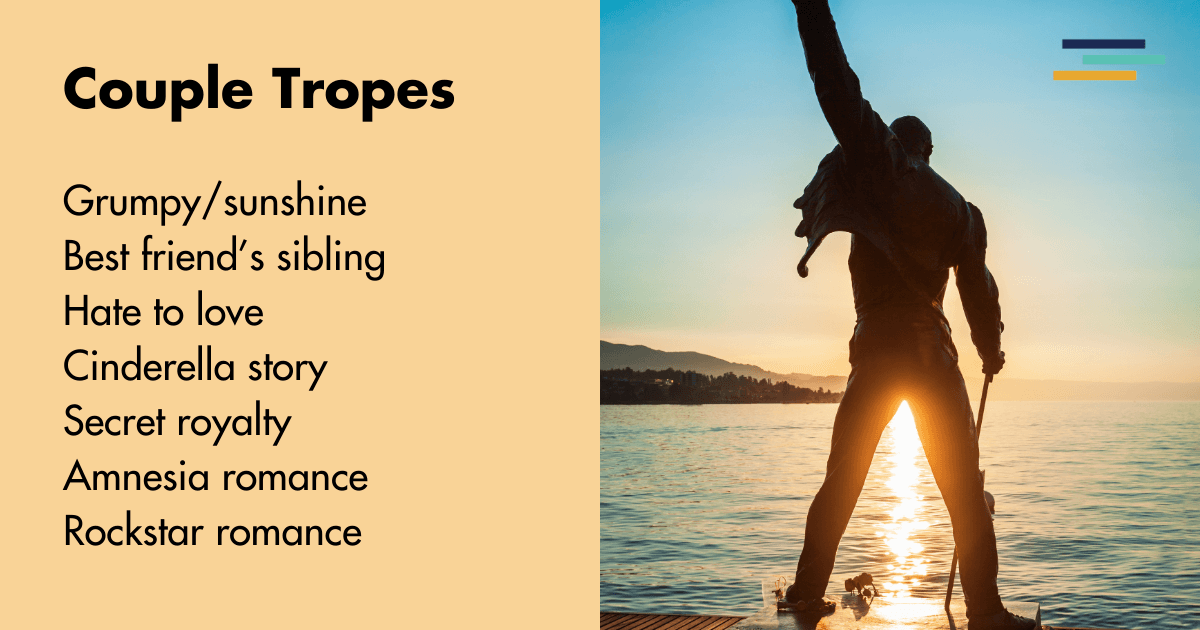
Romantic Tropes Based Around Jobs
- Workplace Romance: A romance that starts because the love interests work in the same place. It’s characterized by the tension and conflict that arise from balancing personal and professional relationships. Example: The Assistants by Camille Perri.
- Bodyguard Romance: Where a bodyguard and the person they’re protecting fall in love. It’s characterized by the way romantic feelings can develop in stressful situations. Example: Midnight Alias by Elle Kennedy.
- Medical Romance: Love stories where the romance is between doctors and/or nurses, and the setting is a hospital. It’s characterized by the emotionally high stakes of a romance developing in the high-stress world of healthcare. Example: The Doctor’s Secret by Heidi Cullinan.
- Firefighter Romance: One love interest is a firefighter. It’s characterized by themes of bravery, sacrifice, and intense emotional bonds. Example: The Fireman Who Loved Me by Jennifer Bernard.
- Military Romance: A romance where one love interest is a soldier and the other love interest is a civilian. It’s characterized by the challenges faced by the civilian love interest because of their relationship with a member of the armed forces. Example: Beyond the Point by Claire Gibson.
- Sports Romance: One love interest is a highly paid sports person. It’s characterized by themes of competition, passion, and the act of balancing a professional sports career with a relationship. Example: The Wall of Winnipeg and Me by Mariana Zapata.
- Billionaire Romance: Similar to the Cinderella Story trope, but one love interest is a powerful billionaire, and the power in the relationship initially rests with them. It’s characterized by themes of power dynamics and excessive wealth. Example: Fifty Shades of Grey by E.L. James.
- Royalty/Commoner: This differs from the Secret Royalty trope because the royal character isn’t always hiding their heritage, but it still features a relationship between a royal and a member of the public. It’s characterized by the culture clash between two people who come from wildly different worlds. Example: The Royal We by Heather Cocks and Jessica Morgan.
- Chef Romance: A romance between chefs or people in the culinary industry. It’s characterized by passionate characters who love their careers, and these novels are usually highly sensory because they center on food. Example: Sweetbitter by Stephanie Danler.
- Detective/Criminal: Where one love interest is a cop, and the other is the suspect of a crime or involved in criminal life. It’s characterized by the tension and conflict that arises from a relationship that treads a thin line between desire and duty. Example: The Chase by Janet Evanovitch and Lee Goldberg.
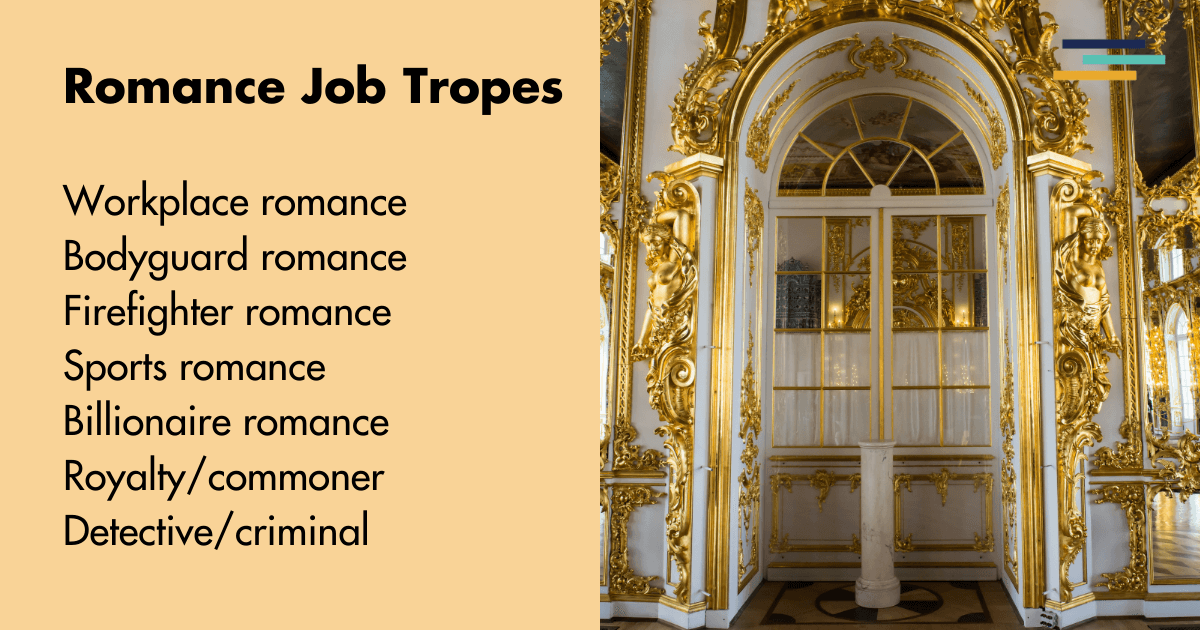
Story Tropes for Personality Traits
- Nerd/Jock: One love interest is nerdy, bookish, and unpopular, while the other is athletic, sporty, and popular. It’s characterized by challenging personality stereotypes. Example: The Locker Room by Meghan Quinn.
- Rebel/Royal: A rebellious character falls in love with a member of the royal family. It’s characterized by a contrast between defiance and duty and the breaking of social divides. Example: Red, White & Royal Blue by Casey McQuiston.
- Shy Hero/Heroine: A shy protagonist falls in love with a super confident love interest. It’s characterized by the shy character finding inner confidence and the confident character finding the beauty in quietude. Example: Aristotle and Dante Discover the Secrets of the Universe by Benjamin Alire Sáenz.
- Protective Alpha: A strong Alpha character who resists love falls for their more gentle love interest. It’s characterized by darker themes of control and dominance. Example: The Billionaire’s Obsession by J.S. Scott.
- Adventurous Hero/Heroine: An adrenaline junkie character falls in love.It’s characterized by the thrill of excitement and unbreakable bonds formed by shared experiences. Example: Cinder by Marissa Meyer.
- Caregiver/Caretaker: One love interest works in care, and the other love interest is their patient. It’s characterized by a central theme of sacrifice and the power behind acts of kindness. Example: Me Before You by Jojo Moyes.
- Artist/Muse: Where an artist falls in love with their inspiring muse. It’s characterized by two creative people falling in love because of their shared interests. Example: Fangirl by Rainbow Rowell.
- Reclusive Billionaire: A cousin to Billionaire Romance, Reclusive Billionaire occurs when the billionaire love interest rarely leaves their mansion or sparingly makes public appearances. Characterized by themes of power and the transformative nature of freedom. Example: The Billionaire’s Obsession by J.S. Scott.
- Brooding Hero: A broody and dark protagonist falls for someone. It’s characterized by the brooding character dealing with their inner demons so they can be in a loving, committed relationship. Example: The Darkest Touch by Gena Showalter.
- Innocent and Experienced: A romance between a love interest with an innocent, idealistic outlook and a love interest who is more streetwise and worldly. It’s characterized by the contrast between experience and naivety. Example: Wait for You by J. Lynn.
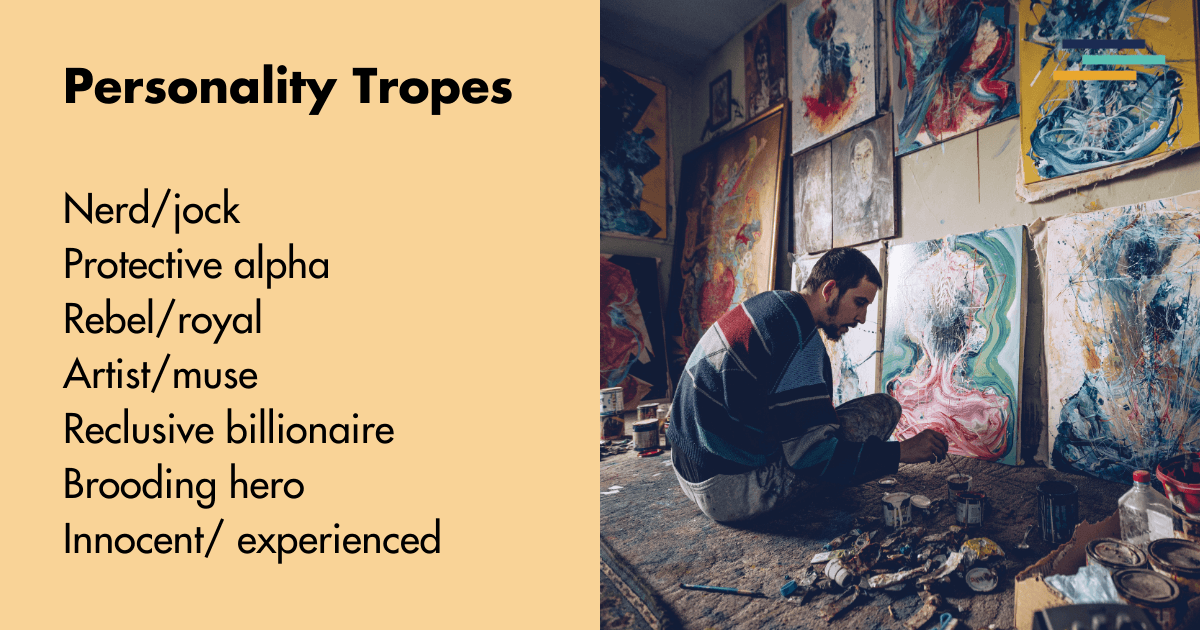
Why You Shouldn’t Be Afraid of Common Romance Tropes
There are two huge reasons you shouldn’t be afraid of using common romance tropes in your fiction.
Romance Tropes Make Novels Easier to Write
Tropes often come with built in plot structures. We know enemies to lovers stories start with the leads hating each other and end with them being in love. So, as a writer, you know the path the novel must take before you begin, giving you an advantage.
Romance Tropes Are Perfect for Marketing
When you mention a trope to a romance reader, they know two things:
- What your novel is about
- Whether that trope is for them
By using tropes in your marketing, you’ll attract the right readers while putting off the wrong ones.
It’s a win-win.
We know every writer is unique. And the great thing about tropes is you can take a familiar one and twist it into something original. It all comes down to the way you execute the story. We suggest you use the Fictionary Software to enhance your personal style rather than fit your story into a box.


